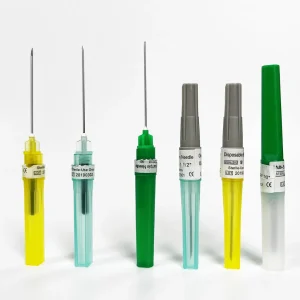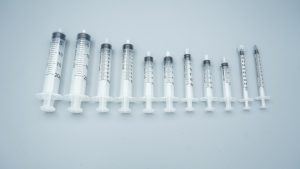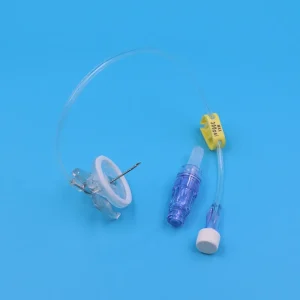In the medical device industry, medical injection needles may appear to be minor components, yet they play a crucial role in patient safety, injection efficacy, and comfort. As a professional needle supplier, we understand that different clinical scenarios, drug viscosities, and administration requirements demand diverse needle gauge sizes. This comprehensive guide explores needle specifications, their significance, and evolution, helping healthcare facilities and distributors make informed purchasing decisions.
Understanding Needle Gauge Sizes: The Complete Specification Chart
Medical needles are measured using the Gauge system (G), where higher numbers indicate smaller diameters. The term “Gauge” represents the needle’s outer diameter following international measurement standards. Below is the standard specification chart for hypodermic needles:
| Gauge Size | Outer Diameter | Primary Applications |
|---|---|---|
| 14G | 2.10 mm | Blood transfusion, rapid fluid infusion, high-volume aspiration |
| 16G | 1.60 mm | IV catheterization, large molecule drug delivery |
| 18G | 1.20 mm | General medication administration, phlebotomy |
| 20G | 0.90 mm | Routine injections, intramuscular (IM) administration |
| 22G | 0.70 mm | Intravenous (IV) therapy, pediatric/geriatric care |
| 23G | 0.60 mm | Subcutaneous injections, vaccine administration |
| 25G | 0.50 mm | Subcutaneous delivery, aesthetic procedures |
| 27G | 0.40 mm | Precision injections, insulin delivery, cosmetic applications |
| 30G | 0.30 mm | Micro-dosing, precision drug delivery |
Needle length (measured in inches or millimeters) is equally critical. Standard medical needle lengths range from 0.5 inches (13mm) to 1.5 inches (38mm), with specific applications:
- Short needles (0.5 inches): Subcutaneous or shallow tissue injections
- Long needles (1-1.5 inches): Intramuscular or deep tissue administration
Why Needle Gauge Differentiation Matters in Clinical Practice
The differentiation of needle gauge sizes extends beyond standardization—it directly impacts patient safety and treatment outcomes. Here’s why needle specifications are critical:
1. Drug Viscosity Considerations
Medications vary significantly in viscosity, particle size, and dosage volume. High-viscosity solutions (oils, nutritional emulsions) require larger needle gauges (18G-20G) to ensure adequate flow rates, while low-viscosity medications (vaccines, insulin) work optimally with fine-gauge needles (25G-30G) to minimize discomfort.
2. Anatomical Site Requirements
Different injection sites have varying subcutaneous tissue depths. Intramuscular injections demand longer, thicker medical needles, while subcutaneous administration requires shorter, finer needle gauges to prevent deep tissue trauma.
3. Patient Population Variables
Pediatric, geriatric, and immunocompromised patients have more delicate skin and vascular structures, necessitating smaller gauge needles (25G-27G) to reduce bleeding and pain perception.
4. Clinical Procedure Demands
Specialized fields—aesthetic medicine, insulin therapy, vaccine programs—require precise dosage control and penetration depth, demanding high-precision needle specifications with specific length-diameter combinations.
The Evolution of Medical Needle Standards: A Historical Perspective
The history of injection needles dates to the mid-19th century. The first hypodermic needle was invented by British physician Alexander Wood in 1853. Early needle designs were limited, hand-crafted by physicians, lacking standardized dimensions.
With industrial manufacturing advances and medical standardization, needle specifications became unified:
- Early 1900s: Europe and North America adopted the Gauge (G) system to standardize needle diameters
- Mid-to-late 20th century: Disposable syringe proliferation drove expansion of needle gauge varieties
- 21st century onwards: Minimally invasive techniques and precision medicine pushed needle evolution toward thinner, shorter, higher-precision designs, including ultra-fine needles (29G-33G) for aesthetics, insulin, and vaccines
Today, medical needle specifications represent more than numerical values—they embody clinical needs, drug properties, and patient experience optimization.
Why the Growing Diversity of Needle Gauge Options?
The expansion of needle gauge varieties isn’t manufacturing complexity—it’s the natural outcome of specialized medical demands:
- Diversified Clinical Applications From traditional IV therapy and IM injections to modern aesthetic procedures, precision drug delivery, and laboratory micro-operations, each application requires specific flow rates and penetration depths.
- Enhanced Patient Experience Standards Modern healthcare prioritizes “pain-free injection” and “comfort care,” driving medical needle development toward finer, sharper designs.
- Pharmaceutical Formulation Innovation Long-acting medications, suspensions, and oil-based formulations impose specific requirements on needle gauge dimensions and materials.
- Customization and Specialization Trends As hospital-pharmaceutical partnerships deepen, more institutions now order custom needle specifications tailored to their unique product characteristics.
Needle Materials and Coating Technology: The Overlooked Quality Factors
Many procurement professionals focus solely on needle gauge sizes while overlooking needle materials and surface treatment technologies—crucial factors affecting injection experience and safety.
1. Stainless Steel Grade Differences
Most medical needles use 304 or 316L medical-grade stainless steel. Compared to standard 304, 316L stainless steel contains higher molybdenum content, offering superior corrosion resistance and biocompatibility—ideal for prolonged indwelling or specialized drug delivery. As a professional needle manufacturer, we exclusively use 316L medical-grade stainless steel across all product lines, ensuring every needle meets the strictest medical standards.
2. Silicone Coating: The Lubrication Breakthrough
Silicone coating technology represents a major advancement in needle manufacturing. Uniformly applied medical-grade silicone dramatically reduces penetration resistance, minimizing patient discomfort while preserving needle sharpness. Our needle products employ ultrasonic siliconization, ensuring coating uniformity and adhesion, meeting USP Class VI biocompatibility standards.
3. Corrosion Prevention and Sterilization Protocols
Disposable needles risk oxidation during storage and transport if improperly handled. Professional needle suppliers implement passivation treatment and ethylene oxide (EO) sterilization, maintaining sterility and optimal performance throughout shelf life.
4. Needle Tip Precision Engineering
Needle tip manufacturing quality directly impacts penetration pain. Premium needles utilize tri-bevel grinding or laser-cutting technology, ensuring tip sharpness and smoothness to minimize tissue trauma. As a supplier, we employ electropolishing technology for tip finishing, creating ultra-smooth surfaces that significantly enhance injection comfort.
Needle-Syringe Compatibility: Integrated System Solutions
When purchasing needles separately, customers often encounter needle-syringe compatibility issues—leakage, detachment, or injection difficulties. As an experienced needle supplier, we strongly recommend attention to these integration factors:
1. Luer Connection Standards
Needle-syringe connections primarily use Luer fittings (Luer Lock/Luer Slip). Luer Lock features threaded locking for high-pressure injections or frequent needle changes; Luer Slip offers slip-on convenience with slightly reduced seal integrity. Procurement must verify syringe interface types to ensure needle specification compatibility.
2. Needle Length-Syringe Volume Coordination
Large-capacity syringes (20ml, 50ml) typically pair with thicker, longer medical needles (18G-20G) for adequate flow rates; small-capacity syringes (1ml, 3ml) match fine-gauge needles (25G-30G) for precision delivery. We offer integrated needle-syringe solutions ensuring optimal system performance.
3. Safety Needle Emergence
Growing needlestick injury prevention awareness has accelerated safety needle demand. These safety needles feature automatic retraction or shielding mechanisms that conceal needle tips post-injection, effectively preventing accidental injuries. We’ve developed multiple safety needle products with customizable protection structures per customer requirements.
Selecting the Right Needle Supplier: Critical Evaluation Criteria
For healthcare facilities and distributors, choosing a reliable medical needle supplier affects not only product quality but also clinical safety and brand reputation. Focus on these key dimensions:
1. Manufacturing Credentials and Certifications
Professional needle manufacturers must hold complete medical device production licenses, ISO13485 quality management certification, plus CE, FDA, and other international approvals. These credentials constitute the “market entry threshold” for needle products and directly demonstrate supplier capabilities.
2. Comprehensive Gauge Range Availability
Quality needle suppliers should offer complete needle gauge ranges from large-bore (14G-18G) to ultra-fine needles (27G-33G), covering IV therapy, IM injections, subcutaneous delivery, and aesthetic applications—meeting one-stop procurement needs.
3. Customization Service Capabilities
With personalized medicine trends, pharmaceutical companies and aesthetic clinics increasingly require custom needle specifications. Professional needle suppliers should possess ODM/OEM capabilities, providing end-to-end services from needle design and tooling development to mass production based on drug properties, syringe compatibility, and brand packaging requirements.
4. Quality Assessment Standards
Evaluate needle quality through these indicators: ① Needle tip sharpness without burrs; ② Smooth, rust-free cannula; ③ Uniform silicone coating; ④ Intact, undamaged packaging; ⑤ Complete product certification and traceability documentation.
5. Supply Stability and Responsiveness
The medical industry demands needle supply reliability. Needle suppliers need sufficient capacity reserves, comprehensive inventory management, and rapid response mechanisms to ensure on-time delivery for emergency and bulk orders.
Global Needle Market Trends and Supplier Response Strategies
From our perspective as a needle supplier, the global medical needle industry exhibits these major development trends:
1. Minimally Invasive, Pain-Free Demand Escalation
Ultra-fine needles (29G-33G) experience surging demand in vaccine administration, insulin delivery, and aesthetic applications. Needle suppliers must continually advance tip machining precision and wall thickness control, achieving “thinner, more flexible” designs while maintaining structural integrity.
2. Environmental Sustainability Requirements
Massive disposable needle consumption creates medical waste disposal pressures. Some countries and regions now promote recyclable needle components and biodegradable packaging. As a responsible needle supplier, we’ve launched green manufacturing initiatives, progressively adopting renewable packaging materials to reduce environmental impact.
3. Smart Needle Technology Exploration
Integrating IoT and sensor technology, smart needles can monitor injection depth, flow rates, and completion status in real-time, supporting precision medicine. Though still developmental, this represents the future direction of needle products.
4. Regional Supply Chain Localization
Post-pandemic, medical device supply chain security has become a global priority. Leading needle manufacturers are accelerating regional production facility and distribution center establishment in major markets, shortening delivery cycles and enhancing supply stability.
Professional Recommendations from Your Needle Supplier
As a specialized needle manufacturer and supplier, we recommend healthcare facilities, distributors, and brand clients consider these factors when selecting needle gauges:
- Drug properties: High-viscosity medications require larger needle gauges
- Injection site: Determine needle length and diameter based on tissue depth
- Patient demographics: Pediatric and geriatric populations suit fine-gauge needles
- Usage frequency and cost: Disposable needles must balance cost and quality
- Compatibility requirements: Ensure needle-syringe interface standard alignment
- Safety protection needs: Consider safety needles for healthcare worker protection
We supply the complete needle gauge range from 14G to 33G, supporting OEM/ODM custom needle services to meet diverse market and product line requirements. Standard custom needle minimum orders typically start at 100,000 units, with development cycles of 30-45 days (including sampling confirmation), varying by customization complexity.
Frequently Asked Questions About Medical Needles
Q1: Can medical needles be reused? A: Absolutely not. Disposable medical needles must never be reused, as this creates infection risks, tip dulling, and medication residue—serious safety hazards. This is a fundamental safety principle for medical needle usage.
Q2: How do I distinguish needle gauge applications? A: Focus on the needle specification’s G-value and length. Large-bore needles (14G-20G) serve infusion and phlebotomy; medium needles (22G-25G) handle routine injections; ultra-fine needles (27G-33G) enable insulin, vaccine, and aesthetic precision procedures.
Q3: What matters most when choosing a needle supplier? A: Prioritize: ① Medical device manufacturing credentials; ② Needle specification completeness; ③ Needle material and manufacturing quality; ④ Custom needle service capabilities; ⑤ Supply stability and after-sales support. Professional needle manufacturers should maintain complete quality traceability systems.
Q4: Why does needle material matter? A: Needle materials directly affect biocompatibility, corrosion resistance, and safety. 316L medical-grade stainless steel is the optimal choice, offering higher medical safety standards compared to conventional materials.
Conclusion: Partnering with Professional Needle Suppliers for Medical Safety Excellence
Though medical injection needles are small components in the medical device ecosystem, they carry tremendous responsibility for precision treatment, patient safety, and healthcare experience. From needle gauge diversification to needle material and manufacturing advancement, every technical breakthrough stems from unwavering commitment to medical quality.
As a professional needle supplier with years of industry expertise, we recognize that only continuous R&D investment, stringent production quality control, and customized needle services can truly satisfy modern medical market diversity. Whether disposable needle wholesale, precision needle manufacturing, or safety needle customization, we apply the highest standards in medical needle production to ensure every needle meets international medical device standards.
We offer complete needle gauge ranges from 14G to 33G, covering IV therapy, IM injections, subcutaneous delivery, aesthetic applications, and all clinical scenarios. Our needle products utilize 316L medical-grade stainless steel, advanced silicone coating technology, and electropolishing processes, ensuring every injection is safe, comfortable, and precise.
Choosing a reliable medical needle supplier means choosing steadfast medical safety assurance. We look forward to partnering with healthcare facilities, distribution partners, and pharmaceutical enterprises, delivering superior needle products and solutions to safeguard every injection and advance high-quality healthcare development worldwide.





